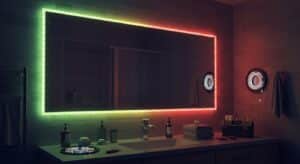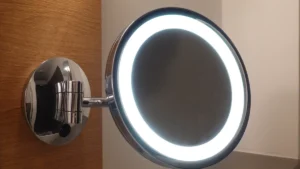
When you see the CE certified mark on LED strip lights, it means more than just a symbol. CE certification shows these lights follow strict European safety rules. It proves the product was tested and meets environmental laws. For buyers, this means safer and better lighting options.
LED strip lights without CE certified status cannot be sold in Europe. This mark also helps people trust the product because it shows good quality. By picking CE certified LED strip lights, you choose safety, long-lasting use, and care for the environment.
Key Takeaways
CE certification means LED strip lights are safe and eco-friendly in Europe.
Look for the CE mark when buying LED strip lights to ensure safety.
Using CE-certified lights lowers the chance of overheating or electrical problems.
CE certification lets companies sell their products all over Europe by following EU rules.
Picking CE-certified LED lights helps the environment by using less harmful materials and energy.
What Is CE Certification?
Definition and Purpose of CE Certification
CE certification is a rule that checks product safety in Europe. It ensures products meet health, safety, and environmental rules. This applies to many items like electronics, toys, and medical tools. A CE mark on a product means it follows these rules. It also allows the product to be sold in Europe easily.
For makers, CE certification works like a trade pass. It helps them meet rules in 30 European countries. To get certified, they must follow these steps:
Find the rules and standards for their product.
Test the product in a lab to check safety.
Create technical documents about the product.
Write a Declaration of Conformity (DoC).
Put the CE mark on the product.
This process makes sure products like LED lights are safe and eco-friendly.
Products That Require CE Certification
Many items need CE certification to be sold in Europe. These include:
Electronics like LED strip lights and home devices.
Medical tools like implants and testing equipment.
Toys and safety gear like helmets.
Building materials and machines.
Each item must follow certain rules, like the Low Voltage Directive (LVD) or Electromagnetic Compatibility (EMC) Directive. For example, LED lights must meet safety and energy-saving rules to get certified.
CE Certification for LED Strip Lights
CE certification for LED strip lights ensures they meet strict European rules. The CE mark shows they follow safety, performance, and eco-friendly standards. It also proves they are free from harmful materials, as required by the RoHS Directive.
LED strip lights with CE certification have many advantages. They work well, save energy, and are better for the planet. Plus, they can be sold across Europe, giving you safe and high-quality lighting options.
When buying LED strip lights, always check for the CE mark. This ensures the product meets important safety and quality rules in Europe.
Why Is CE Certification Important for LED Strip Lights?

Keeping LED Lights Safe and Reliable
CE certification helps make LED strip lights safe to use. Choosing CE-certified lights means they meet strict safety rules. These rules lower risks like shocks, overheating, or fires. For example, the materials used are strong and safe for long use. This keeps your home or workspace protected.
Reliable lighting also means steady performance. CE-certified lights are tested to ensure they stay bright and save energy. This gives you better lighting that lasts longer and works well.
Following Legal Rules for Selling
To sell LED strip lights in Europe, CE certification is required. The CE mark is like a ticket to enter the European market. It shows the product follows EU rules like the Low Voltage Directive (LVD). These rules make sure the lights are safe and don’t harm other devices.
Without CE certification, selling LED lights in Europe is not allowed. Manufacturers must follow these rules to sell their products. For buyers, the CE mark means the product is safe and legal to use.
Protecting the Environment and Health
CE certification also checks if LED lights are eco-friendly and safe. The RoHS Directive bans harmful materials like lead and mercury in lights. This helps reduce pollution and keeps people healthy.
By picking CE-certified lights, you help the planet. These lights use less energy, cutting electricity use and pollution. They also don’t release harmful substances, making them safer for you and your family.
Key Rules for Certifying LED Strip Lights
EMC Rule (Electromagnetic Compatibility)
The EMC rule makes sure LED strip lights don’t mess with other electronics. Badly made LEDs can send out waves that disturb nearby devices. To follow this rule, companies must test their lights for electromagnetic safety. These tests check if the lights work without causing or receiving interference.
For you, this means a dependable product. CE-certified LED strip lights meet these rules, so they work well in your home or office. They won’t mess up devices like Wi-Fi routers or TVs.
LVD Rule (Low Voltage Rule)
The LVD rule checks the electrical safety of LED strip lights. It applies to lights that run on certain voltage levels. This ensures they are safe for daily use. Companies must test their products and create safety documents to meet this rule. They also need to add the CE mark to show they follow safety standards.
When you buy LED strip lights with LVD certification, you lower risks like shocks or overheating. This rule ensures the lights are tested for safety, giving you confidence in your choice.
RoHS Rule (Restriction of Harmful Substances)
The RoHS rule makes sure LED strip lights don’t have harmful materials like lead or mercury. This rule helps protect the environment and keeps people safe. Companies must meet these rules to avoid breaking laws in places like Europe, the UAE, and the U.S.
Rule Focus | Details |
|---|---|
Rule Name | RoHS |
Banned Materials | Lead, Mercury, Cadmium, Flame Retardants |
Goal | Protect nature, reduce health risks, ensure safety |
By picking LED strip lights with RoHS certification, you help the planet. These lights are safer for your family and better for the Earth. They cut down on harmful waste and pollution.
Extra Certifications for LED Strip Lights
When buying LED strip lights, look for extra certifications. These certifications check for better safety, quality, and performance. They go beyond the basic CE rules. They focus on things like energy use, chemical safety, and how long the lights last. Knowing about these can help you pick the right product.
Here are some important certifications for LED strip lights:
Certification | What It Means |
|---|---|
RoHS Certification | Makes sure no harmful chemicals are in the lights. Keeps them safe and eco-friendly. |
REACH Certification | Checks chemical safety during making and using. Ensures safe handling and disposal. |
ERP Certification | Focuses on saving energy and lowering environmental harm. |
LM80 Certification | Tests how long LED chips last and how well they work. |
EN62471 Certification | Makes sure the lights don’t harm your eyes or skin. |
ETL Certification | Proves the lights meet North American safety rules. |
UL Certification | Shows the lights passed safety and performance tests. |
BIS Certification | Confirms the lights meet Indian safety and quality rules. |
CB Certification | Helps products meet global safety standards for easier selling. |
IECEE Certification | Simplifies international safety checks for electrical items. |
ISO9001:2015 Certification | Ensures good quality control and happy customers. |
Waterproof Test Report | Proves the lights can handle water and dust for outdoor use. |
These certifications help you judge LED strip lights better. For example, RoHS and REACH make sure the lights are free of bad chemicals. This makes them safer for you and the planet. ERP certification helps save energy and cut electricity costs. LM80 ensures the lights last a long time and stay bright.
By picking LED strip lights with these certifications, you get safe, reliable, and eco-friendly products. You also know they meet global safety and quality standards.
Benefits of CE-Certified LED Strip Lights
Safety and Quality Assurance
CE-certified LED lights are safe and reliable to use. They go through strict tests to prevent dangers like overheating or shocks. Certifications like LM80 check how long the lights last. EN62471 ensures the lights are safe for your eyes and skin. REACH and RoHS confirm they don’t have harmful chemicals. This keeps you and the environment safe.
When you buy CE-certified LED lights, you can trust their quality. These lights work well, save energy, and last a long time. They are a smart choice for homes and businesses. The CE mark shows the product passed safety tests, giving you peace of mind.
Compliance with EU Regulations
CE certification makes sure LED lights follow EU safety and environmental rules. Companies must meet rules like the Low Voltage Directive (LVD) and RoHS Directive. These rules ensure the lights are safe and eco-friendly.
The CE mark is needed to sell LED lights in Europe. It proves the product passed safety checks and meets EU standards. This protects buyers and ensures companies follow the same safety rules.
Access to European Markets
The CE mark allows companies to sell products in 30 European countries. It removes extra rules and lowers costs for businesses. Many non-EU countries also accept the CE mark, opening more markets.
For buyers, this means getting safe, high-quality LED lights. By choosing CE-certified lights, you support eco-friendly practices. You also get reliable and energy-saving lighting for your needs.
Building Consumer Trust
The CE mark on LED strip lights is not just a label. It means the lights are safe, high-quality, and follow rules. This mark shows the maker followed strict European standards. It helps you trust the product because it meets safety and environmental guidelines.
Why Trust Matters in Lighting Products
Trust is important when picking LED strip lights. You need lights that work well and last long. CE-certified lights pass tough tests for safety and performance. This lowers risks like overheating or shocks. Choosing certified lights keeps your home and family safe.
Tip: Look for the CE mark before buying LED strip lights. It ensures safety and quality.
Transparency Through Certification
CE certification makes companies share clear information about their products. They must provide technical files and a Declaration of Conformity. These prove the lights meet EU safety rules. When you buy CE-certified lights, you know the company is honest about its checks.
Benefits for You
Peace of Mind: Certified lights are safer and work reliably.
Eco-Friendly Choice: These lights follow rules to protect the planet.
Long-Term Savings: They last longer and use less energy, saving money.
By picking CE-certified LED strip lights, you choose products you can trust. The CE mark ensures safety, quality, and rule-following, giving you confidence in your choice.
Risks of Using Non-Certified LED Strip Lights

Safety and Fire Hazards
Non-certified LED strip lights can be dangerous to use. They often skip proper testing and use cheap materials. This increases the chance of problems like overheating. Overheating can cause electrical shorts or even fires. Bad wiring or damaged cords make these risks worse, especially near flammable items.
Another issue is poor installation. Non-certified lights may not include clear instructions. This can lead to bad ventilation or wrong power supply use. Overheating power sources or overloaded circuits can create unsafe conditions. To stay safe, always pick LED lights that meet safety standards.
Risk Factor | Description |
|---|---|
Quality of LED Strip Lights | Cheap materials in non-certified lights raise fire risks. |
Incorrect Power Supply Usage | Wrong power supplies can overheat and cause short circuits. |
Poor Installation Practices | Bad installation traps heat, increasing fire dangers. |
Overloaded Electrical Circuit | Too many lights on one circuit can overheat wires. |
Legal and Financial Risks
Using non-certified LED lights can cause legal and money problems. These products often break EU safety rules, making them illegal to sell in Europe. If you buy or use them, you might be responsible for damages from fires or electrical issues.
Sellers of non-certified lights face legal troubles too. They must prove their products are safe if accidents happen. Insurance claims may also be denied if non-certified lights are involved. This leaves buyers and sellers at risk of paying for damages. Choosing certified LED lights helps avoid these problems.
Environmental Consequences
Non-certified LED lights often fail to meet eco-friendly rules like the RoHS Directive. They may have harmful materials like lead or mercury. These can hurt the environment if not disposed of properly. Certified LED lights help reduce pollution and support green practices.
Certified lights also save energy, lowering electricity use and cutting greenhouse gases. Non-certified lights may waste more energy, raising bills and harming the planet. By choosing certified products, you make a safer and greener choice for the Earth.
How to Make Sure LED Strip Lights Follow CE Rules
Steps for Makers
Checking Product Safety
To get CE certification, makers must check their products for safety. This process ensures LED strip lights meet safety and eco-friendly rules. First, find the rules that apply, like the Low Voltage Directive (LVD) for electrical safety and the RoHS rule to limit harmful materials. Test the lights to ensure they don’t interfere with other devices. Following these steps helps make sure the lights are safe and ready for sale in Europe.
Creating Important Documents
Making proper documents is key for CE certification. These papers prove the LED strip lights follow all rules. Include product details, test results, and safety checks. Also, write a Declaration of Conformity (DoC) to confirm the product meets EU rules. Good documents show the product is safe and help build trust with buyers and regulators.
Adding the CE Mark
After passing all tests and finishing the documents, add the CE mark. This mark shows the LED strip lights meet CE rules. Put the mark where it can be easily seen on the product or box. Make sure it’s the right size and style to avoid problems. The CE mark allows the product to be sold in Europe and shows it’s safe and high-quality.
Tips for Buyers
Spotting the CE Mark
When buying LED strip lights, look for the CE mark. It should be easy to see on the product or box. This mark means the lights meet EU safety and eco-friendly rules. Watch out for fake marks that don’t guarantee safety.
Checking Product Papers
Ask for papers to confirm the product follows CE rules. Look for a Declaration of Conformity, which proves the lights meet EU standards. These papers show the lights are safe and reliable to use.
Picking Trusted Sellers
Buy from sellers who follow CE rules. Good sellers give clear product details and papers. They make sure their lights are safe and eco-friendly. Choosing trusted sellers helps you avoid unsafe or fake products.
CE certification is important for keeping LED strip lights safe and reliable. When you pick CE-certified lights, you get products that meet strict safety rules. These lights are tested to ensure they work well and last long. CE certification also lets companies sell their lights in Europe without any legal problems.
Using non-certified LED lights can be risky. They might not follow safety rules and could cause problems. CE-certified lights follow EU rules, protect the environment, and work better for a longer time. Always choose certified lights for safe and high-quality lighting.
Aspect | CE-Certified LED Lights | Non-CE-Certified LED Lights |
|---|---|---|
Market Access | Yes | No |
Compliance with EU Standards | Yes | No |
Assurance of Safety and Quality | Yes | No |
Legal and Regulatory Issues | None | Potential Issues |
Tip: Check for the CE mark before buying LED strip lights. It shows the product is safe and follows EU rules.
FAQ
What does the CE mark on LED strip lights mean?
The CE mark means the LED strip lights follow European safety rules. It shows the product passed tests and meets EU standards. This mark ensures the lights are safe, reliable, and good for the environment.
How can I check if an LED strip light is CE-certified?
Check for the CE mark on the product or box. Ask the seller for a Declaration of Conformity (DoC). This paper proves the product meets EU safety rules. Buying from trusted sellers helps you get real CE-certified lights.
Are CE-certified LED strip lights better for the environment?
Yes, CE-certified lights follow the RoHS rule, which bans harmful materials like lead. They also save energy, cutting electricity use and pollution. Choosing these lights helps protect the Earth and supports eco-friendly habits.
Can I use non-CE-certified LED strip lights in Europe?
No, non-CE-certified lights cannot be sold or used in Europe. They might not meet safety or eco-friendly rules, causing risks like overheating or pollution. Always pick CE-certified lights for safety and legal use.
Why should I choose CE-certified LED strip lights?
CE-certified lights are safer and follow EU rules. They lower risks like electrical problems and environmental harm. These lights last longer, save energy, and are a smart choice for homes or businesses.
See Also
Understanding Cob Led Strips: Functionality Explained
Selecting The Perfect LED Strip Lights For Linear Lighting
Adjustable Brightness Options For Cob Led Strips
Comparing High-Intensity LED Strips For Various Uses
COB Versus SMD LED Strips: Differences And Uses



